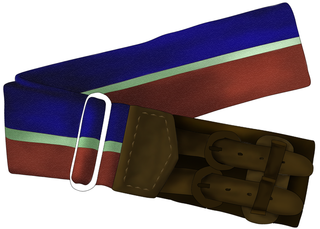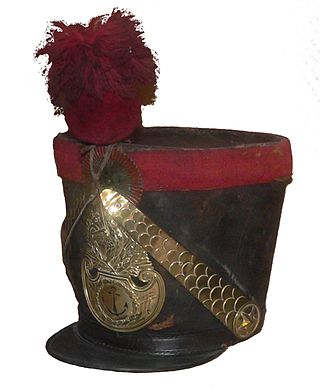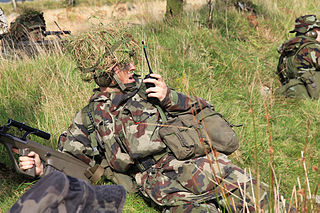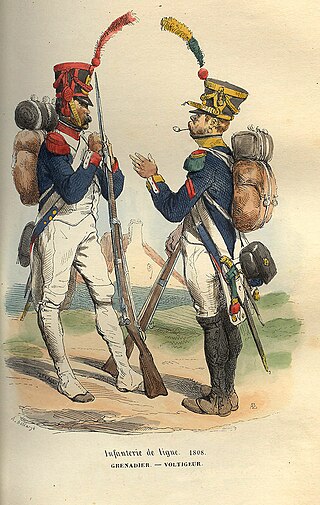

Valise Equipment, Pattern 1888 (also known as Slade-Wallace Equipment) was a leather harness used by the British Armed Forces.


Valise Equipment, Pattern 1888 (also known as Slade-Wallace Equipment) was a leather harness used by the British Armed Forces.
The equipment was designed in 1888 by Colonel Slade and Major Wallace for use with the first .303-inch calibre rifles, replacing the Valise Equipment, Pattern 1870, [1] which had entered service in 1871. The Slade-Wallace Equipment weighed 25 pounds (11 kg), which was the lightest infantry equipment issued to British troops up to that time. [2] The belts, straps and pouches were made from buff coloured leather, which was whitened with pipe clay; the haversack was made of white canvas, except for rifle regiments which had black. [3]
It was the standard equipment worn by British and Imperial infantry during the Second Boer War. It proved unsuitable for holding modern ammunition, because the pouches had been designed before the introduction of the clip charger which allowed for rapid reloading, and could only accommodate individual rounds. The leather also tended to deteriorate during long periods in the field. After the war, review of the British Army's performance was conducted by the 1903 Royal Commission on the War in South Africa, which heard evidence that the Slade-Wallace equipment was "cumbersome, heavy and badly balanced" and "an absurdity". As a stop-gap measure, the leather 1903 Bandolier Equipment was issued, but it quickly proved to be unsuitable for infantry use and was itself replaced by the 1908 Pattern Webbing. [4]
After the outbreak of the First World War, quantities of Slade-Wallace equipment sets were brought out of storage for the use of recruits in training, [5] and was used on active service by some British colonial troops in the East African campaign. [6] The whitened Slade-Wallace equipment continued to be worn for ceremonial duties by the Brigade of Guards until 1939, [7] and other regiments in that era sometimes wore the whitened belt with Service Dress on formal occasions. [8]
The complete equipment consisted of:
Complementary Equipment:

The leather was coloured according to regiment. It was left buff and then coloured black for rifle regiments, and whitened on the outer surfaces for infantry regiments. [1] A pouch with a reserve magazine (for the Lee-Metford/Lee-Enfield rifle), like a spade, was worn only with the appropriate order. Outside of the marching order, one ammunuition pouch was worn (on the back, or on the right side). [12] The special magazine pouch nominally was a possible element of equipment until the introduction of SMLE No. 1 Mk. I and 1903 Bandolier Equipment, but were not mass issued in practice, with some particular exceptions for some squads and positions. [13] [14] [15] The supply of reserve magazines and pouches for issue as part of standard equipment was stopped on October 1890 and those already supplied to the troops should have be returned to storage (LoC 6235 of 10.03.1890 and LoC 6233 of 10.06.1890). There are examples of what is believed to be a magazine pouch, introduced around 1900, that match the pattern of Slade-Wallace equipment in fittings and materials, but were not strictly included in the set. They appear to have been put into very limited use only. [16] [17]

A bandolier or a bandoleer is a pocketed belt for holding either individual cartridges, belts of ammunition or grenades. It is usually slung sash-style over the shoulder and chest, with the ammunition pockets across the midriff and chest. Though functionally similar, they are distinct from chest rigs, which are designed to hold magazines instead.

Fusilier is a name given to various kinds of soldiers; its meaning depends on the historical context. While fusilier is derived from the 17th-century French word fusil – meaning a type of flintlock musket – the term has been used in contrasting ways in different countries and at different times, including soldiers guarding artillery, various elite units, ordinary line infantry and other uses.

A stable belt is a striped coloured belt worn at times by the armed forces of the United Kingdom, other Commonwealth countries, and a few other countries including Denmark, Brazil and Lebanon. The stripes vary by regiment and corps, identifying the wearer's unit. In Brazil and Lebanon they are known as gymnastic belts.

A military uniform is a standardised dress worn by members of the armed forces and paramilitaries of various nations.

A jerkin is a man's short close-fitting jacket, made usually of light-coloured leather, and often without sleeves, worn over the doublet in the 16th and 17th centuries. The term is also applied to a similar sleeveless garment worn by the British Army in the 20th century. A buff jerkin is an oiled oxhide jerkin, as worn by soldiers.

A shako is a tall, cylindrical military cap, usually with a visor, and sometimes tapered at the top. It is usually adorned with an ornamental plate or badge on the front, metallic or otherwise; and often has a feather, hackle, or pompom attached at the top.

Personal Load Carrying Equipment (PLCE) is one of several tactical webbing systems of the British Armed Forces. Dependent upon the year of design, and the decade of introduction, the webbing system was named and is commonly referred to as the 85 Pattern, the 90 Pattern or the 95 Pattern webbing.
Forage cap is the designation given to various types of military undress, fatigue or working headwear. These vary widely in form, according to country or period. The coloured peaked cap worn by the modern British Army for parade and other dress occasions is still officially designated as a forage cap.

Blanco was a compound used primarily by soldiers throughout the Commonwealth from 1880 onwards to clean, colour, and waterproof their equipment as well as reduce its stiffness. It was first used by the British Army to whiten Slade Wallace buckskin leather equipment, and later adapted to coloured versions for use on the 1908 Pattern Web Equipment. Blanco was also used on the 1937 Pattern Web Equipment, though in this case it was primarily used for camouflage purposes since fitting instructions now permitted the use of conventional cleaning methods.

A facing colour, also known as facings, is a common tailoring technique for European military uniforms where the visible inside lining of a standard military jacket, coat or tunic is of a different colour to that of the garment itself. The jacket lining evolved to be of different coloured material, then of specific hues. Accordingly, when the material was turned back on itself: the cuffs, lapels and tails of the jacket exposed the contrasting colours of the lining or facings, enabling ready visual distinction of different units: regiments, divisions or battalions each with their own specific and prominent colours. The use of distinctive facings for individual regiments was at its most popular in 18th century armies, but standardisation within infantry branches became more common during and after the Napoleonic Wars.

The uniforms of the British Army currently exist in twelve categories ranging from ceremonial uniforms to combat dress. Uniforms in the British Army are specific to the regiment to which a soldier belongs. Full dress presents the most differentiation between units, and there are fewer regimental distinctions between ceremonial dress, service dress, barrack dress and combat dress, though a level of regimental distinction runs throughout.

Service Dress is the style of khaki service dress uniform introduced by the British Army for use in the field from the early 1900s, following the experiences of a number of imperial wars and conflicts, including the Second Boer War. This variant of uniform continues to be worn today, although only in a formal role, as No. 2 Pattern dress.

The modern Greek Army has a history of almost 200 years, during which it has undergone dramatic changes and been involved in some of the major conflicts on the European continent. The modern Greek military throughout its history was closely following international developments in equipment and uniforms. With the notable exception of the elite Evzones units, which based their uniforms on the indigenous traditional garments of the 18th century, the rest of the Army, as most militaries worldwide, was always quick to adopt the military fashion current among the armies of the influential Great Powers. This influence can be roughly divided in three periods: French-style uniforms, which dominated throughout the 19th century, the British styles introduced around World War I and used during World War II and until the late 1960s, and the "NATO" or US-style predominating from ca. 1968 onward. Various individual items or details can of course be traced to other influences, and there were also transitional uniforms combining previous designs.
The military uniforms of the Union Army in the American Civil War were widely varied and, due to limitations on supply of wool and other materials, based on availability and cost of materials. The ideal uniform was prescribed as a dark blue coat with lighter pants, with a black hat. Officer's ranks were denoted with increasing levels of golden decoration. Specific jobs, companies, and units had markedly different styles at times, often following European customs such as that of the Zouaves. Officers uniforms tended to be highly customized and would stray from Army standard. Ironically, several main pieces of gear had been created by order of the U.S. War Secretary Jefferson Davis before the war; he later became Confederate President.

The British Army used a variety of standardized battle uniforms and weapons during World War I. According to the British official historian Brigadier James E. Edmonds writing in 1925, "The British Army of 1914 was the best trained best equipped and best organized British Army ever sent to war". The value of drab clothing was quickly recognised by the British Army, who introduced Khaki drill for Indian and colonial warfare from the mid-19th century on. As part of a series of reforms following the Second Boer War, a darker khaki serge was adopted in 1902, for service dress in Britain itself. The British military authorities showed more foresight than their French counterparts, who retained highly visible blue coats and red trousers for active service until the final units received a new uniform over a year into World War I. The soldier was issued with the 1908 Pattern Webbing for carrying personal equipment, and he was armed with the Short Magazine Lee–Enfield rifle.
The 21st Punjabis were an infantry regiment of the British Indian Army. It was raised in 1857, as the 11th Regiment of Punjab Infantry. It was designated as the 21st Punjabis in 1903 and became 10th (Training) Battalion of 14th Punjab Regiment in 1922. In 1943, it was converted into the 14th Punjab Regimental Centre. In 1947, the 14th Punjab Regiment was allocated to the Pakistan Army. In 1956, the 1st, 14th, 15th and 16th Punjab Regimental Centres where amalgamated to form the Punjab Regimental Centre.

1937 Pattern Web Equipment was an item of military load-carrying equipment. It replaced the 1908 Pattern and 1925 Pattern—on which it was based—and was standard issue for British and Commonwealth troops from its introduction in 1937, throughout World War II, and in the post-war period until it was superseded by 1958 Pattern Web Equipment. It remained in limited use with Territorial Army and other second-line troops until the mid to late 1970s. Official use of the webbing in Community Cadet Forces and the Combined Cadet Force persisted into the 1980s.

The 1908 Pattern Web Infantry Equipment was an innovative type of webbing equipment adopted by the British Army before World War I.

In military uniforms, a shoulder belt is a wide belt worn usually over the shoulder and across the body. With nearly all line infantry, skirmishers, light infantry, grenadiers and guard regiments, two shoulder belts were worn - one carrying the cartridge box, and another for the bayonet, a sword, or other military equipment.
The uniforms of the Australian Army have changed significantly over the past century, although the accoutrements worn over this period have remained relatively similar. The forces of the Australian colonies and the early forces of the Commonwealth post-Federation in 1901 closely followed the uniforms of the British Army. Since then it has continued to be influenced by British but also US styles, as well as including some distinctly Australian designs, reflecting local conditions and trends.